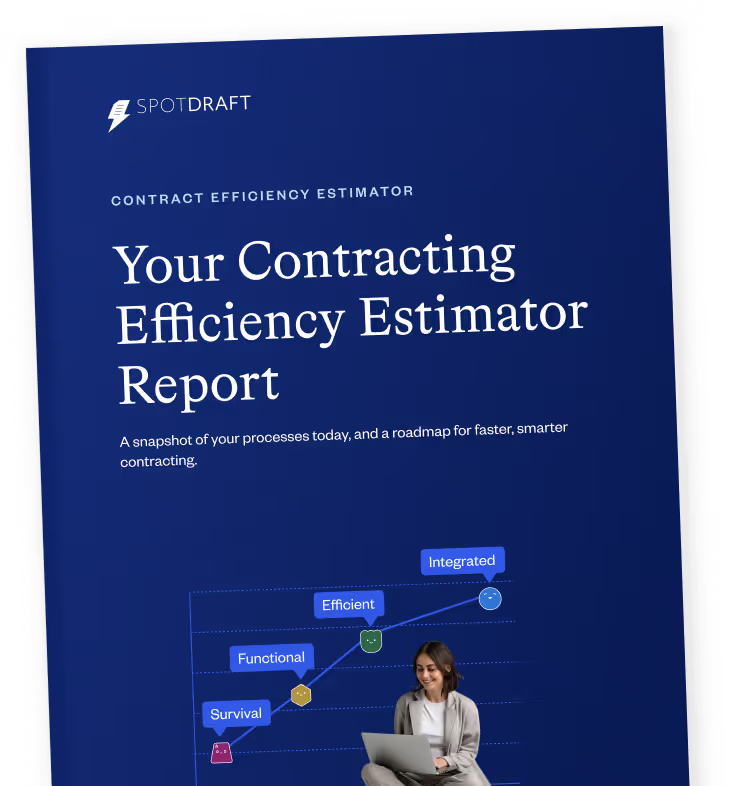So, you just got notified about a new prospect ready to seal a deal with your consulting firm. For the umpteenth time in a rather short timeframe, your expertise as the in-house counsel has been called upon for the drafting, reviewing, and negotiation of the consulting agreement.
While new client onboarding means more revenue for your organization, the constant cycle of drafting, reviewing, and negotiating contracts from scratch for every new prospect can be counterproductive. It can put a strain on your team’s capacity, resulting in slow processes and increased risk of oversights, inconsistencies, and legal vulnerabilities.
To fix this, you must implement a framework that empowers all teams with the right strategies, best practices, and templates to handle routine processes independently.
This is what a consulting agreement playbook is about.
In this guide, we will delve into what a consulting agreement playbook entails, its various benefits, and best practices for proper implementation.
What is a consulting agreement playbook?
A consulting agreements playbook is a comprehensive guide that details procedures, best practices, and templates for drafting, negotiating, and managing consulting agreements.
As the business world continues to evolve, businesses are constantly served with equal measures of challenges and opportunities. Navigating these situations can sometimes require specialized knowledge that may not exist within the scope of the organization’s internal expertise.
In such situations, relying solely on internal resources may not be sufficient. To bridge the knowledge or skill gap, organizations may choose to seek external expertise through consulting.
A consulting agreement exists to ensure that consulting firms and their clients conduct transactions on clear, well-defined, and legally binding terms.
However, creating, reviewing, and negotiating a consulting agreement every time a new client surfaces isn’t always convenient for in-house counsel, especially when the consulting firm is onboarding multiple clients simultaneously.
However, with a consulting agreement playbook, legal and non-legal teams within the firm will have access to a predefined framework for navigating every part of consulting agreements. This expedites the contracting process, reduces the burden on legal teams, and ensures that all client engagements are conducted in a consistent and legally sound manner.
What does a consulting agreement playbook contain?
The exact content of a consulting agreement playbook varies according to the organization's needs, the industry, and the nature of the consulting service. However, the elements discussed below are common among all consulting agreement playbooks.
#1 Contracting process workflow
The contracting process workflow outlines the step-by-step procedures for initiating, negotiating, and finalizing consulting agreements.
It typically covers stages such as request initiation, needs assessment, contract drafting, legal review, negotiation, approval, execution, and post-execution management.
#2 Roles and responsibilities
This section defines the responsibilities of each party involved in the contracting process. It outlines the roles of individuals such as contract managers, legal advisors, consultants, and any other stakeholders relevant to the consulting agreement.
#3 Contract templates
Here, the playbook offers standardized templates for various types of consulting agreements. These templates often include standard terms and conditions, defining the scope of work, deliverables, payment terms, confidentiality clauses, and other relevant provisions.
“The absence of contract templates leads to non-standardization and makes contracts prone to errors. The legal team, therefore, is required to delve deep into contracts and proofread all clauses with a fine-tooth comb to identify and rectify the simplest of human errors.”
~ Igor Poroger, Director of Legal, EMEA, Vectra AI
How CLMs Empower Legal Teams in B2B SaaS Companies
#4 Guidelines for contract review
This section provides detailed guidance on how to review a contract effectively. It may include a checklist of key elements to scrutinize, potential risks to look out for, and considerations for compliance with legal and regulatory requirements.
Also read: The Perfect Contract Review Checklist
#5 Approval procedures
Detailed in this section are the procedures for obtaining approvals at various stages of the contracting process.
The playbook specifies the levels of authorization required for different types of contracts, ensuring that the appropriate individuals or teams review and approve contracts based on their complexity, value, and potential impact on the organization.
Also read: How to Set Up an Efficient Contract Approval Process (+Template & Examples)
#6 Compliance and legal considerations
In this section, the playbook outlines guidelines to ensure that contracts adhere to legal and regulatory requirements, industry standards, and internal policies.
This includes considerations for data protection, intellectual property, and other legal aspects relevant to the organization's industry and jurisdiction.
Also read: What is Contract Compliance? The Ultimate Guide
#7 Negotiation strategies
“True negotiation is not ‘I win, you lose.’ There may be times when that could be the case, but the party on the other side will hate you and will look for ways to screw you over the first chance they get.”
~ Sterling Miller, CEO and Senior Counsel, Hilgers Graben PLLC
Ten Things: Business Skills All In-House Lawyers Must Know
Here, the playbook offers recommendations on best practices for streamlining negotiations.
It typically covers proven strategies for making win-win offers, the organization’s Minimum Acceptable Terms (MAT), common bottlenecks encountered during negotiations, and how to adapt to situations with BATNA (Best Alternative to a Negotiated Agreement).
#8 Dispute resolution procedures
In the event of a dispute between the parties, this section outlines the procedures for resolving conflicts. It covers various dispute resolution mechanisms like mediation, arbitration, and litigation, as well as the laws and jurisdiction governing the agreement.
#9 Risk management
This part identifies common risks associated with contract agreements and offers guidelines for managing and mitigating these risks. It may include a risk assessment framework, checklists, key risk indicators, and proven mitigation strategies.
Also read: Contract Risk Assessment Checklist
#10 Contract lifecycle management
This component focuses on ongoing contract management beyond the initial agreement. It includes guidelines for monitoring key dates, tracking contract performance, and managing renewals, amendments, or terminations.
#11 Tech stack
This section covers the tools and technologies that support the lifecycle of the consulting agreement. This may include contract management software, electronic signature tools, document collaboration platforms, etc., depending on the needs and preferences of the organization.
It may also include guidance on how to integrate these tools into the overall workflow.
#12 Additional resources
Here, the playbook may provide additional resources that may be useful to its target users. This may include webinars, video tutorials, sample documents, legal references, FAQs, and case studies, among others.
Why your organization needs a consulting agreement playbook
Implementing a consulting agreement playbook within your organization can bring several benefits, contributing to convenience, efficiency, cost savings, and overall productivity.
Here are some key reasons why having a consulting agreements playbook can be advantageous for your organization.
#1 Consistency and standardization
A playbook ensures that all consulting agreements adhere to standardized terms and conditions. This reduces variability and minimizes the risk of errors or oversights.
#2 Time efficiency
With predefined workflows, templates, and clear guidelines, the contracting process becomes more efficient. In-house counsel can save time by not reinventing the wheel for each new consulting agreement, enabling them to focus on more strategic legal matters.
#3 Cost savings
“You can't keep adding the same proportion of legal people to take care of inexpensive processes like building word documents, spreadsheets, etc. You can't scale and keep adding costs.”
~Stephanie Dominy, Consultant GC, and Startup Advisor
The Future of Legal Leadership: Why Fractional GCs Are On the Rise
The playbook contributes to cost savings by reducing the time and resources spent on negotiations and legal reviews. It also minimizes the likelihood of legal disputes and associated expenses due to unclear or incomplete terms.
#4 Risk mitigation
The consulting agreement playbook includes guidelines for identifying and managing risks associated with consulting contracts. This helps mitigate legal and operational risks, protecting the organization from potential disputes and liabilities.
#5 Improved compliance
By incorporating legal and regulatory considerations into the playbook, organizations can ensure that all consulting agreements comply with relevant laws and industry standards, reducing the risk of non-compliance and associated penalties.
#6 Seamless onboarding for new intakes
“A playbook is a lifesaver to new attorneys joining the department as they can get quickly up to speed on the parameters of the company’s contract negotiation positions.”
~Sterling Miller, CEO, Hilgers Graben Pllc
Ten Things: Creating A Good Contract Playbook
The playbook serves as a comprehensive training resource for new team members, ensuring a consistent understanding of the organization’s contracting process, legal considerations, and negotiation strategies.
#7 Efficient approval process
Clearly defined approval procedures in the playbook help expedite decision-making processes.
By specifying the levels of authorization required for different types of contracts, the organization can avoid delays and ensure that the right stakeholders are involved at the appropriate stages.
Best practices for implementing a consulting agreement playbook
Creating and implementing a comprehensive consulting agreement playbook is often a rigorous process, requiring keen attention to detail and careful consideration of applicable regulations.
By following the best practices discussed below, you will build a playbook that not only protects your organization legally but also ensures consistency and clarity in your consulting engagements.
#1 Involve relevant stakeholders in the building process
Incorporating input from key stakeholders is crucial when developing a consulting agreement playbook. This may include legal experts, project managers, finance professionals, and other team members relevant to the contract.
This ensures that the playbook addresses the diverse needs and concerns of different departments, enhances its practicality, and helps in achieving broader organizational goals.
Additionally, this approach fosters a sense of ownership and collaboration, increasing the likelihood of successful implementation.
#2 Prioritize flexibility
Consulting engagements often involve unique circumstances and requirements. Design the playbook with a focus on flexibility, allowing for customization based on the specific needs of each project or client.
This adaptability ensures that the consulting agreement remains relevant in various situations, fostering positive client relationships and accommodating changes in the dynamic business environment.
#3 Keep it simple
Simplicity is key when it comes to the language and structure of the consulting agreement playbook. Ensure that the content is clear, concise, and easily understandable by all parties involved.
A straightforward playbook reduces the likelihood of misunderstandings, disputes, and legal complications.
#4 Implement a change management strategy
Introducing a new consulting agreement playbook may represent a significant change for your organization. Implementing effective change management strategies is crucial to ensure a smooth transition.
Communicate changes transparently, address concerns proactively, and provide training and support to those affected. A well-managed change process enhances the likelihood of successful adoption and minimizes resistance.
#5 Monitor the playbook consistently
Regular monitoring is essential to assess the effectiveness of your consulting agreement playbook. Establish a system for ongoing evaluation, seeking feedback from stakeholders involved in consulting engagements.
This feedback loop allows your organization to identify areas for improvement, address emerging challenges, and continuously refine the playbook to better meet the needs of the business.
#6 Incorporate a training program
Develop a training program to educate employees and relevant stakeholders on the content and processes outlined in the consulting agreement playbook.
Proper training enhances awareness of legal and procedural requirements, reducing the likelihood of errors and ensuring that everyone follows the established guidelines.
#7 Explore opportunities to leverage technology
Almost every phase in the lifecycle of consulting agreements can be automated. Take legal reviews as an example. With an AI-powered tool like VerifAI, you can accurately and comprehensively analyze your consulting agreements 15 times faster, with minimal manual input.
This is thanks to its robust database of pre-vetted playbooks from industry-leading legal professionals and generative AI algorithms.
Also read: How AI Contract Review Tools are Transforming Legal Workflows
VerifAI not only scans your consulting agreements for errors and risky clauses but also offers clear explanations for its assessments, providing you with a transparent and informative basis for decision-making.
Additionally, the platform runs on Natural Language Processing (NLP) algorithms, which makes it capable of understanding and providing answers to open-ended questions.
Alongside its native playbooks, VerifAI allows you to upload your custom consulting agreement playbook for a more tailored contract review experience.
On a broader scale, SpotDraft offers a robust ecosystem of contract management tools you can leverage to bring your playbook to life. These tools streamline processes like contract drafting, document management, reporting, eSignature, and more.
Incorporating technology into your consulting agreement playbook will streamline workflows, improve accessibility, and enhance the overall efficiency of the playbook.
Wrapping up
Indeed, a consulting agreement playbook is a valuable resource for organizations in the consulting business. By offering a standardized framework for handling contracts, an adequately implemented playbook will spare legal and non-legal professionals the hassle of reinventing the wheel for every new intake.
This not only reduces the workload but also ensures consistency and adherence to established best practices while allowing teams to focus on the unique aspects of each consulting engagement.
As you strive to help your organization grow, remember that technology will always be your ally.
With SpotDraft’s CLM and VerifAI, every phase of your consulting agreement can be streamlined, empowering you with bandwidth for more valuable contributions.
Click here to try VerifAI for free.
What to see a demo of SpotDraft? Click here to send a request.


.avif)







